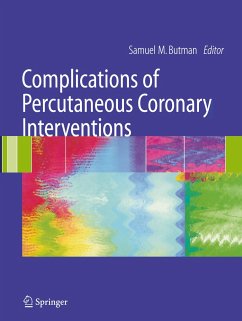This book complements available texts that detail percutaneous coronary interventions and is dedicated solely to the associated complications. By covering the range of complications that arise, from medication related to difficulties with closure devices, this text helps physicians improve care by anticipating or recognizing problems earlier. Chapters focus on specific steps of interventions and include cases that reflect scenarios seen in clinical practice. Cardiac arrest, legal matters, and adverse event reporting are also addressed. Essential information is easily accessible in useful tables. Cardiologists, as well as interventional radiologists who perform these procedures, will appreciate the logically organized and nicely illustrated format. This key text is ideal for regular use but also has value as a need-to-know reference.
Every physician hates to have a patient develop a complication. Nevertheless, we also know that when a problem does develop, one needs a clear corrective strategy to minimize the effect of the complication and thereby prevent a major morbid event. The most frightening of all cardiologic complications occur in the catheterization laboratory. Indeed, Lewis Dexter, one of my mentors, told me about his first, accidental catheterization of the pulmonary artery. When he saw,under the fluoroscope, that the catheter was dancing back and forth in the lung, Dr. Dexter was convinced that he had perforated the patient's heart while trying to thread the catheter through the right atrium to the renal veins. However, after some thought and observation, he realized that he had not encountered a complication; instead he had tripped upon the opportunity to diagnose and understand various forms of heart diseases. Clin ical cardiac catheterization had been born! The 14 chapters in this book have various real-life complications that have occurred during coronary intervention. They also describe various strategies for avoiding or managing them. The chapters take the reader sequentially through a variety of situations, anyone of which would make for a potentially "bad day" in the catheterization laboratory. Starting with medication prob lems,the authors work their wayfrom the groin to the coronary arteries, detail ing unpleasant situations and how to deal with them.
Hinweis: Dieser Artikel kann nur an eine deutsche Lieferadresse ausgeliefert werden.
Every physician hates to have a patient develop a complication. Nevertheless, we also know that when a problem does develop, one needs a clear corrective strategy to minimize the effect of the complication and thereby prevent a major morbid event. The most frightening of all cardiologic complications occur in the catheterization laboratory. Indeed, Lewis Dexter, one of my mentors, told me about his first, accidental catheterization of the pulmonary artery. When he saw,under the fluoroscope, that the catheter was dancing back and forth in the lung, Dr. Dexter was convinced that he had perforated the patient's heart while trying to thread the catheter through the right atrium to the renal veins. However, after some thought and observation, he realized that he had not encountered a complication; instead he had tripped upon the opportunity to diagnose and understand various forms of heart diseases. Clin ical cardiac catheterization had been born! The 14 chapters in this book have various real-life complications that have occurred during coronary intervention. They also describe various strategies for avoiding or managing them. The chapters take the reader sequentially through a variety of situations, anyone of which would make for a potentially "bad day" in the catheterization laboratory. Starting with medication prob lems,the authors work their wayfrom the groin to the coronary arteries, detail ing unpleasant situations and how to deal with them.
Hinweis: Dieser Artikel kann nur an eine deutsche Lieferadresse ausgeliefert werden.
Aus den Rezensionen:
"... Die Abschnitte sind knapp gehalten; die Informationen werden komprimiert weitergegeben, immer ist ein starker Praxisbezug vorhanden. Die Autoren, bekanntermaßen ausgewiesene Experten der interventionellen Kardiologie, geben einen breiten Überblick über die häufigsten Komplikationen ... Alle Passagen werden durch umfangreiches Bildmaterial ergänzt. In allen Kapiteln wird auf umfangreiche weitergehende Literatur verwiesen ..." -- in: internistische praxis, 2007, Vol. 47, Issue 3, S. 476
"... Die Abschnitte sind knapp gehalten; die Informationen werden komprimiert weitergegeben, immer ist ein starker Praxisbezug vorhanden. Die Autoren, bekanntermaßen ausgewiesene Experten der interventionellen Kardiologie, geben einen breiten Überblick über die häufigsten Komplikationen ... Alle Passagen werden durch umfangreiches Bildmaterial ergänzt. In allen Kapiteln wird auf umfangreiche weitergehende Literatur verwiesen ..." -- in: internistische praxis, 2007, Vol. 47, Issue 3, S. 476








